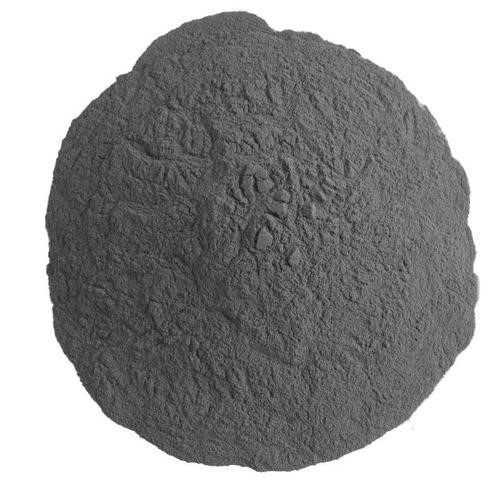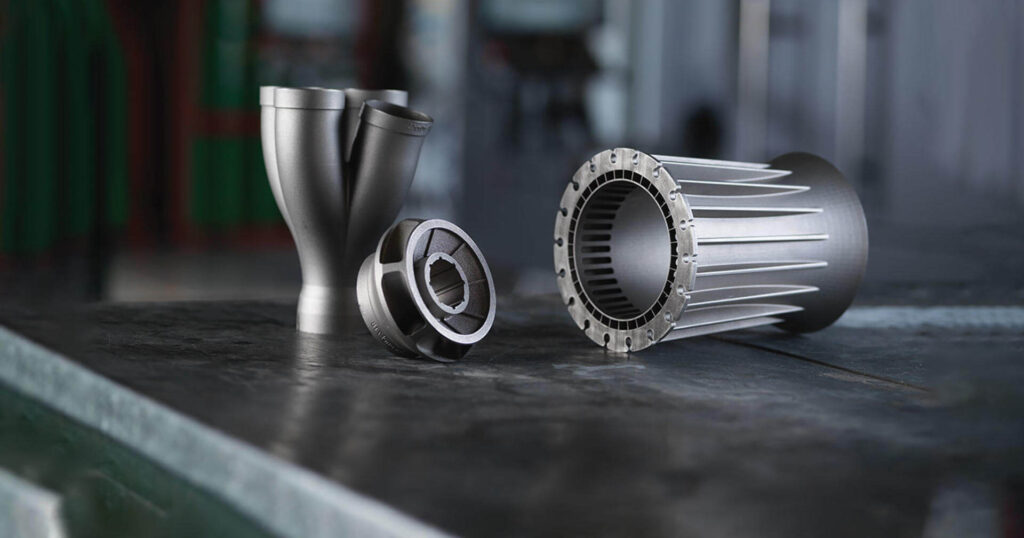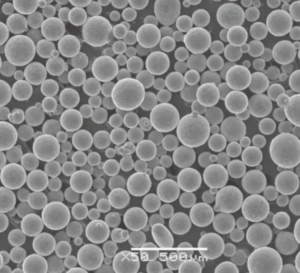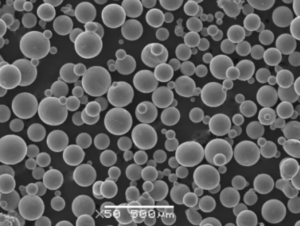ニオブ粉末の紹介
ニオブ粉 は、様々な産業における技術進歩の最前線にある注目すべき材料である。そのユニークな特性と多彩な用途で、ニオブ粉末は大きな注目を集め、現代の製造工程に革命をもたらしている。この記事では、ニオブ粉末の世界を掘り下げ、その特性、製造方法、さまざまな分野での広範な使用について探ります。
ニオブとは何か?
定義と特徴
ニオブは記号Nb、原子番号41の化学元素で、遷移金属グループに属する銀色の柔らかい金属である。タンタルと類似しており、鉱物の中に一緒に含まれていることが多い。高融点、優れた耐熱性、優れた超伝導特性で知られ、さまざまな産業で欠かせない存在となっている。
ニオブの用途
ニオブの優れた特性は、航空宇宙や電子機器から医療機器や原子力技術に至るまで、さまざまな分野で応用されている。合金を強化し、軽量化するその能力は、エンジニアリングと製造における新たな可能性を切り開いた。

ニオブ粉末製造
ニオブ鉱石の抽出
ニオブの主な供給源は、パイロクロアとコロンバイト-タンタライトという鉱物に含まれている。抽出プロセスでは、これらの鉱石を採掘し、高度な技術を使ってニオブを他の元素から分離する。
精製と加工
一度抽出されたニオブ鉱石は、純粋なニオブ金属を得るために一連の精製工程を経る。これらの工程には、溶媒抽出、沈殿、真空溶解が含まれる。最終製品は、様々な粒径と形状のニオブ粉末に加工される。
ニオブ粉末の種類
球状ニオブ粉
球状ニオブ粉末は、微粒化法によって製造され、均一な形状の粒子が得られる。このタイプのニオブ粉末は、高い流動性と均質な混合を必要とする用途に広く使用されている。
角状ニオブ粉
角型ニオブ粉末は、破砕と粉砕方法によって製造され、不規則な形状の粒子が得られる。最適な性能を発揮するために表面積の増大が不可欠な用途で好まれています。
フレーク状ニオブ粉
フレーク状ニオブ粉末は、バルクのニオブ材をフレーク状 にすることで製造され、薄く板状の粒子が得られる。このタイプのニオブ粉末は、ある種のコーティング剤や潤滑剤など、特殊な用途に使用される。
ニオブ粉末の特性と利点
高い融点と耐熱性
ニオブ粉末は著しく高い融点を示し、極端な温度条件下での使用に最適です。その卓越した耐熱性は、厳しい環境下での安定性と耐久性を保証します。
超伝導と磁気特性
ニオブの最もエキサイティングな特性のひとつは、低温での超伝導性であり、MRI装置や粒子加速器のような用途に欠かせない。ニオブは強力な磁気特性でも知られ、高性能磁石に使われている。
合金の強化と軽量化
ニオブは他の金属と組み合わせることで、合金の強度と機械的特性を大幅に向上させます。さらに、軽量であるため、軽量構造用途に最適です。

工業用途におけるニオブ粉末
航空宇宙
ニオブ合金は、その高い強度対重量比と耐食性により、航空宇宙および航空用途に広く使用されている。軽量で燃料効率の高い航空機や宇宙船の製造に貢献している。
エレクトロニクスと半導体
ニオブは、コンデンサー、超電導線材、半導体など、エレクトロニクス産業において重要な役割を果たしている。ニオブのエレクトロニクスへの利用は、高性能デバイスの開発を可能にしている。
ヘルスケアと医療機器
医療分野では、ニオブは医療用インプラント、歯科補綴物、MRI装置に使用されている。その生体適合性と超伝導特性は、医療用途に理想的な材料となっている。
積層造形におけるニオブ粉末
3Dプリンティングとその利点
アディティブ・マニュファクチャリングの台頭は、ニオブ粉末の用途に新たな可能性をもたらした。ニオブ粉末を使った3Dプリンティングは、複雑な形状やカスタマイズを可能にし、材料の無駄を減らす。
自動車および航空宇宙産業におけるアプリケーション
ニオブ粉末を使った積層造形は、自動車産業や航空宇宙産業に変革をもたらしつつある。ニオブを使った3Dプリンティングで作られた部品は軽量化されるだけでなく、優れた性能と耐久性を発揮する。
原子力技術におけるニオブ粉末
原子炉用ニオブ合金
ニオブ合金は、耐腐食性、中性子吸収性、高温への耐性のため、原子炉で重要な役割を果たしている。
核融合炉におけるニオブ
先進的な核融合研究において、ニオブは超伝導磁石やその他の重要な部品の製造に使用され、クリーンで持続可能なエネルギーの開発に貢献している。
ニオブ粉の環境影響
持続可能性とリサイクル
ニオブの持続可能な利用とリサイクルへの取り組みは、ニオブの生産と使用による環境への影響を最小限に抑える上で重要な役割を果たす。
責任ある調達
ニオブの需要が高まるにつれ、倫理的な採掘と生産を確保するために、責任ある調達慣行が不可欠になっている。
ニオブ粉末の将来展望
技術の進歩
絶え間ない研究開発により、ニオブ粉末の生産と応用が進んでいる。
新たなアプリケーション
技術の進化に伴い、ニオブ粉末の新しいエキサイティングな用途が発見され、その有用性はさらに拡大している。

結論
ニオブ粉末は、人類の創意工夫と技術進歩の探求の力強い証です。その卓越した特性と多様な用途により、この驚異的な素材は、航空宇宙、エレクトロニクスからヘルスケア、原子力技術に至るまで、数多くの産業を形成し、現在も形成し続けている。
ニオブパウダーの製造は、ニオブ鉱石の抽出から始まり、それを精製して純粋なニオブ金属を得るという綿密な工程を経て行われる。出来上がった粉末は、球状、角状、薄片状などさまざまな形状があり、それぞれ特定の用途に合わせて調整される。
高融点、超伝導性、合金強化能力といったニオブ粉末の特性は、様々な分野での普及に大きく貢献している。航空宇宙や航空分野では、ニオブ合金はより軽量で燃料効率の高い航空機の製造を可能にする。エレクトロニクス分野では、ニオブはコンデンサーや超電導線材に応用され、高性能デバイスの開発を推進している。医療分野では、ニオブの生体適合性と超伝導性が役立っており、医療用インプラントやMRI装置に理想的な材料となっている。
積層造形の出現は、ニオブ粉末の新たな可能性を解き放ち、自動車や航空宇宙部品の複雑な設計や性能向上を可能にした。さらに、ニオブは原子力産業においても重要な役割を果たしており、原子炉や先進核融合炉の建設に貢献し、クリーンで持続可能なエネルギーを目指している。
将来に向けて、環境への影響を軽減するために、ニオブの責任ある調達とリサイクルがますます重要になる。持続可能なサプライチェーンを確保するためには、持続可能な慣行と倫理的な採掘を取り入れることが不可欠です。
今後、継続的な研究開発がニオブ粉末製造のさらなる進歩につながり、技術の世界における新しくエキサイティングな用途を開拓していくだろう。
よくある質問
ニオブ粉末の主な用途は?
ニオブ粉末は、そのユニークな特性により、様々な産業で応用されている。主な用途には、航空宇宙・航空部品、電子機器・半導体、医療用インプラント、原子炉建設などがある。
ニオブ粉末はどのようにして作られるのか?
ニオブ粉末は、パイロクロアやコロンバイト-タンタライトのような鉱物からニオブ鉱石を抽出することによって製造される。抽出された鉱石は、溶媒抽出や真空溶解などの精製工程を経て、純粋なニオブ金属を得る。その後、この金属は、さまざまな粒径と形状の粉末に加工される。
ニオブ粉が特定の用途に適している理由は何ですか?
ニオブ粉末は高い融点と耐熱性を誇り、極端な温度条件に適している。その低温での超伝導性は、MRI装置や粒子加速器などの用途に極めて重要である。さらに、ニオブは合金を強化する能力があり、軽量であるため、エンジニアリングや航空宇宙用途で重宝されている。
ニオブ粉末は積層造形にどのように貢献するのか?
ニオブ粉末は積層造形、特に3Dプリンティングにおいて重要な役割を果たしている。複雑な形状の作成、カスタマイズ、材料の無駄の削減を可能にする。この技術は、より軽量で高性能な部品を製造することで、自動車や航空宇宙などの産業に革命をもたらした。
ニオブ粉末は環境に優しいのか?
環境への影響を最小限に抑えるため、ニオブの責任ある調達とリサイクルを確保するための取り組みが行われている。持続可能な慣行と倫理的な採掘は、ニオブ粉末をより環境に優しいものにする上で重要な役割を果たしている。
Frequently Asked Questions (Supplemental)
1) What powder specifications are recommended for AM-grade Niobium Powder?
- Target spherical morphology, PSD for LPBF around 15–45 μm, O ≤0.15 wt%, N ≤0.02 wt%, H ≤0.002 wt% (application-specific); low satellite content; Hall/Carney flow per OEM guidance; provide lot-level powder passports.
2) Is Niobium Powder biocompatible for implants?
- Commercially pure Nb and certain Nb‑containing alloys show excellent biocompatibility and corrosion resistance in physiological media, making them candidates for dental and orthopedic devices. Specify low interstitials and verify via ISO 10993 testing.
3) Can Niobium Powder be processed by binder jetting or MIM?
- Yes. Fine PSD (D50 ≈ 10–20 μm) with tight fines control improves green density and sinterability. Debind/sinter cycles must limit oxidation; vacuum or high‑purity inert atmospheres are preferred. HIP can close residual porosity.
4) How many reuse cycles are acceptable for Nb in LPBF?
- With sieving, blend‑back, and monitoring PSD, flow, and interstitials, many sites qualify 5–8 cycles. Set limits empirically using tensile/fatigue trends and NDE defect analytics; Nb’s oxide pickup can be faster than some steels.
5) What safety considerations are unique to Niobium Powder?
- Fine Nb powder can be reactive at elevated temperatures; manage dust explosibility per DHA. Use inert gas for hot operations, ground all equipment, and follow combustible metal standards (e.g., NFPA 484). Employ appropriate PPE and local exhaust ventilation.
2025 Industry Trends and Data
- Traceability and ESG: Powder passports with chemistry (including Ta, O/N/H), PSD, recycle counts, and responsible sourcing declarations (RMAP) are increasingly required.
- Superconducting demand: Fusion and high‑field magnet programs elevate interest in ultra‑low‑impurity Nb and Nb‑Ti/Nb3Sn precursor powders.
- AM maturation: Qualified LPBF parameters for niobium components in RF cavities, cryogenic hardware, and lightweight aerospace brackets expand; vacuum stress‑relief/HIP routes standardize.
- Recycling: Closed‑loop reclamation programs for Nb machining swarf and unmelted powder gain traction, reducing cost and environmental footprint.
- Supply resilience: Diversification beyond single‑country pyrochlore sources; more contracts include provenance audits and LCA disclosures.
| KPI (Niobium Powder & Applications), 2025 | 2023 Baseline | 2025 Typical/Target | Why it matters | Sources/Notes |
|---|---|---|---|---|
| Oxygen in AM‑grade Nb (wt%) | 0.18–0.30 | 0.08–0.15 | Ductility, toughness | ISO/ASTM 52907 passports |
| LPBF density post‑HIP (%) | 99.5–99.8 | 99.8–99.95 | Fatigue, leak‑tightness | OEM/peer‑reviewed data |
| Qualified reuse cycles (LPBF) | 3–5 | 5–8 | Cost, consistency | Plant case studies |
| Binder‑jet green density (Nb) | 50–54% T.D. | 54–58% T.D. | Predictable shrinkage | OEM notes |
| Recycled content disclosures | 限定 | 20–30% on select lots | ESG/cost | EPD/LCA reports |
| Provenance audits in RFQs | エマージング | Common in defense/energy | Compliance/risk | RMI/RMAP guidance |
Authoritative resources:
- ISO/ASTM 52907 (powder characterization) and 52904 (LPBF practice): https://www.iso.org
- ASTM B822/B214 (PSD), B212/B213 (density/flow), F3302 (AM process control): https://www.astm.org
- ASM Handbook: Powder Metallurgy; Superconducting Materials: https://dl.asminternational.org
- Responsible Minerals Initiative (RMAP): https://www.responsiblemineralsinitiative.org
- NIST AM Bench datasets: https://www.nist.gov/ambench
Latest Research Cases
Case Study 1: LPBF of Cryogenic Valve Components from Niobium Powder for Fusion Systems (2025)
- Background: A fusion technology supplier needed thin‑walled cryogenic valve bodies with internal channels, leveraging Nb’s low‑temperature toughness and compatibility with superconducting systems.
- Solution: Gas‑atomized Niobium Powder (15–45 μm; O 0.10 wt%); LPBF with inert atmosphere (O2 ≤200 ppm), scan strategies to mitigate keyholing; vacuum stress‑relief and HIP; abrasive flow machining for internal passage finishing.
- Results: Post‑HIP density 99.9%; impact energy at −196°C improved 18% vs. wrought baseline; helium leak rate <1×10⁻⁹ mbar·L/s; part consolidation reduced welds by 80%, cutting lead time by 30%.
Case Study 2: Binder‑Jetted Nb Capacitor Anodes with Enhanced CV via Controlled Sintering (2024)
- Background: An electronics manufacturer sought higher capacitance‑voltage (CV) performance and yield for miniature high‑reliability capacitors.
- Solution: Fine angular Nb powder (D50 ≈ 12 μm) for higher specific surface area; debind/sinter in high‑vacuum with oxygen getters; post‑sinter anodization optimization.
- Results: CV increased by 12–15%; scrap rate reduced by 22%; lot‑to‑lot CV variation (Cpk) improved from 1.2 to 1.7; unit cost per anode −10% at scale.
Expert Opinions
- Prof. Michael T. Lanagan, Professor of Engineering Science and Mechanics, Penn State
- Viewpoint: “For high‑reliability Nb capacitor powders, oxygen control and particle topology drive CV and breakdown strength more than incremental changes in pressing pressure.”
- Dr. Carlo Bucci, Senior Materials Scientist, CERN (Superconducting Magnets)
- Viewpoint: “Low‑impurity niobium with rigorous provenance is essential for cryogenic structures; AM components are promising provided HIP and surface finishing deliver cavity‑grade cleanliness.”
- Dr. Martina Zimmermann, Head of Additive Materials, Fraunhofer IWM
- Viewpoint: “Digital powder passports coupled with in‑situ monitoring are accelerating qualification of Niobium Powder for regulated aerospace and energy applications.”
Affiliation links:
- Penn State: https://www.psu.edu
- CERN: https://home.cern
- Fraunhofer IWM: https://www.iwm.fraunhofer.de
Practical Tools/Resources
- Standards and testing: ISO/ASTM 52907; ASTM B822/B214 (PSD), B212/B213 (density/flow); ASTM E1019 (O/N/H)
- AM process development: Ansys Additive or Simufact Additive for scan/distortion; nTopology for internal channels and lattices
- Metrology: LECO inert‑gas fusion for O/N/H (https://www.leco.com); SEM/EDS for morphology and inclusions; CT for porosity and channel verification
- Compliance/ESG: RMI/RMAP guidance for responsible sourcing; EPD/LCA templates for disclosure
- Databases: Senvol Database (https://senvol.com/database); MatWeb (https://www.matweb.com); NIST AM Bench datasets
Last updated: 2025-08-22
Changelog: Added 5 supplemental FAQs; introduced 2025 trend KPI table with sources; provided two case studies (LPBF cryogenic valve components; binder‑jet Nb capacitor anodes); included expert viewpoints with affiliations; compiled standards, simulation, metrology, ESG, and database resources for Niobium Powder.
Next review date & triggers: 2026-02-01 or earlier if ISO/ASTM standards update, major OEMs add provenance/oxygen limits for Nb powder, or new datasets on cryogenic properties and capacitor CV performance are published.

